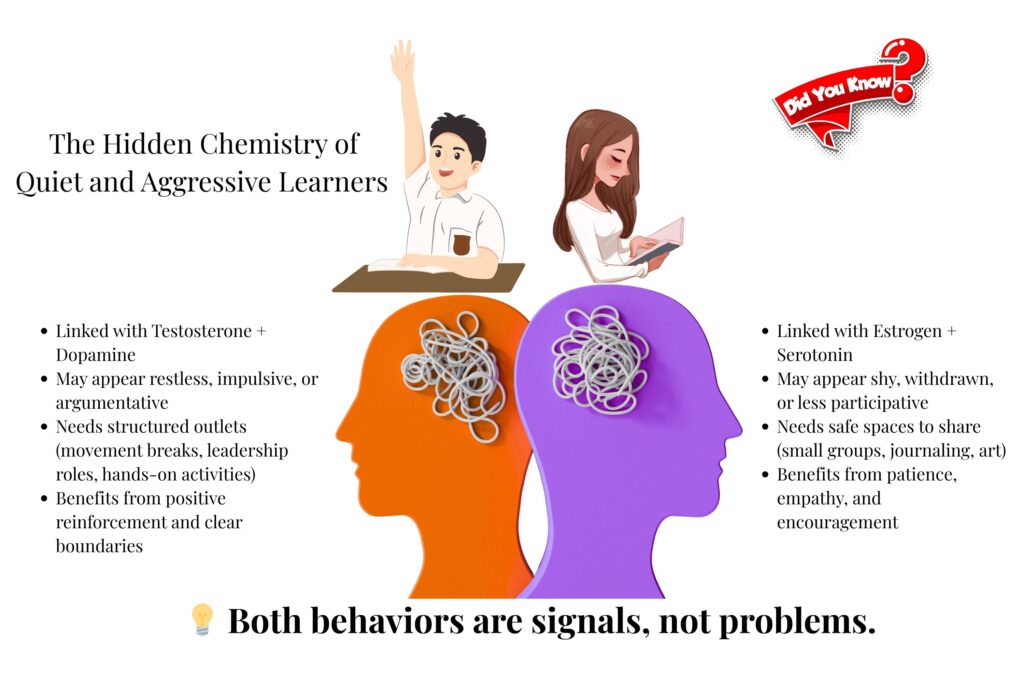
🌱 Two Students, Two Mysteries
Every teacher knows that no two learners are alike. Some fade into the background, while others disrupt the room.
For Ms. Radhika, this contrast lived in the same classroom.
There was Nisha, the bright but silent observer. She never raised her hand, avoided eye contact, and quietly blended into the walls.
And then there was Sachin, the loud disruptor. Quick to anger, restless in his seat, and often in trouble for blurting out or arguing.
Two students, two extremes. But as Ms. Radhika would discover, both were shaped by something deeper than attitude or willpower. Their behavior had roots in their brain chemistry.
🌸 Nisha and the Quietness of Estrogen & Serotonin
At first, Nisha’s silence seemed like shyness. But neuroscience suggests another possibility.
Estrogen supports the brain’s serotonin system, which regulates mood, confidence, and social interaction.
When estrogen levels are steady, serotonin functions smoothly → students feel balanced and willing to participate.
During fluctuations (adolescence, puberty, stress), estrogen dips can lower serotonin activity, leading to withdrawal, low confidence, and quietness.
For Nisha, this meant she wasn’t disengaged — she was silently navigating internal chemistry shifts. With support, she could still shine, but she needed patience and safe spaces to find her voice.
🔥 Sachin and the Storm of Testosterone & Dopamine
On the other hand, Sachin’s behavior often overwhelmed the class. He spoke out of turn, argued easily, and seemed constantly restless.
Again, neuroscience offers a clue.
Testosterone, the hormone linked with drive and dominance, can amplify reactivity.
Dopamine, the brain’s “reward chemical,” fuels the search for excitement and stimulation.
When testosterone is high and dopamine systems are highly sensitive, students may crave stimulation and act impulsively — sometimes showing as aggression or defiance.
For Sachin, his outbursts weren’t just “bad behavior.” They were signals of a brain chemistry pulling him toward high energy and risk-taking. With the right guidance — structured activities, movement breaks, and positive reinforcement — his energy could be channeled into leadership and creativity instead of disruption.
🎒 What This Means for Teachers
Both Nisha and Sachin remind us of an important truth: what we see in the classroom is often shaped by what’s happening inside the brain.
Teachers can respond by:
For quiet learners → Create safe, low-pressure participation opportunities (small groups, journaling, creative tasks).
For aggressive learners → Provide structured routines, opportunities for physical movement, and positive outlets for energy.
For all learners → Lead with empathy. Instead of labeling, ask: “What might be happening beneath the surface?”
🔎 Important to Remember
Silence or aggression in students can stem from many different causes: personality, home environment, emotional experiences, or social influences. The hormone–neurotransmitter links (estrogen–serotonin for quietness, testosterone–dopamine for aggression) are just one possible lens to understand behavior.
Every child is unique — which is why teachers need both science and sensitivity to truly reach them.
🌟 The Bigger Picture
When educators adopt the neural lens, they see beyond behavior. They see signals, not problems. Silence becomes a call for support, and aggression becomes a cry for direction.
✨ At Pipaltree, we help teachers use neuroscience to transform classrooms into spaces where every student — quiet or loud — has the chance to succeed.
Want to transform your school too? Bring the power of new-age teaching & learning.
Contact us to revolutionize your school’s teaching approach today!
In service since: 2010.
